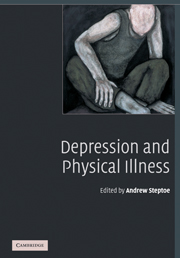Book contents
- Frontmatter
- Contents
- List of contributors
- Preface
- Part 1 Introduction to depression and its determinants
- Part 2 Depression and specific health problems
- Part 3 Biological and behavioural processes
- 12 Inflammation, sickness behaviour and depression
- 13 The hypothalamic–pituitary–adrenal axis: cortisol, DHEA and mental and behavioural function
- 14 Depression and immunity: biological and behavioural mechanisms
- 15 Smoking and depression
- 16 Depression and physical activity
- 17 Depression and adherence to medical advice
- Part 4 Conclusions
- Index
- References
14 - Depression and immunity: biological and behavioural mechanisms
from Part 3 - Biological and behavioural processes
Published online by Cambridge University Press: 17 September 2009
- Frontmatter
- Contents
- List of contributors
- Preface
- Part 1 Introduction to depression and its determinants
- Part 2 Depression and specific health problems
- Part 3 Biological and behavioural processes
- 12 Inflammation, sickness behaviour and depression
- 13 The hypothalamic–pituitary–adrenal axis: cortisol, DHEA and mental and behavioural function
- 14 Depression and immunity: biological and behavioural mechanisms
- 15 Smoking and depression
- 16 Depression and physical activity
- 17 Depression and adherence to medical advice
- Part 4 Conclusions
- Index
- References
Summary
Introduction
Depression has a huge impact on individuals and society, with a lifetime prevalence of over 15%. By 2020, depression will be the second leading illness in the world, as projected by the World Health Organization (WHO). In addition to the emotional consequences of depression, the disorder is increasingly implicated in a wide range of medical conditions. Moreover, a growing body of evidence indicates that depression, including even minor depression, has notable immunological consequences. It is important therefore to consider possible immune mechanisms in the detrimental effects of depression on health, particularly in vulnerable individuals such as elderly people and patients with chronic disease.
This chapter provides a review of the research being conducted on the relationship between depression and immunity, beginning with an overview of the clinical importance of depressive disorders for mortality risk. The various immune alterations that occur during depression are examined, with discussion of the role of autonomic, neuroendocrine and behavioural (e.g., sleep) mechanisms. The chapter concludes with consideration of the clinical implications of immune changes in depression for several medical disorders.
Clinical characteristics of depression
Definition of depression
Depression can be defined as a condition that primarily entails a disturbance of mood; this affective disturbance is often characterised by a mood that is sad, hopeless, discouraged or simply depressed [1].
Keywords
- Type
- Chapter
- Information
- Depression and Physical Illness , pp. 299 - 320Publisher: Cambridge University PressPrint publication year: 2006
References
- 1
- Cited by



